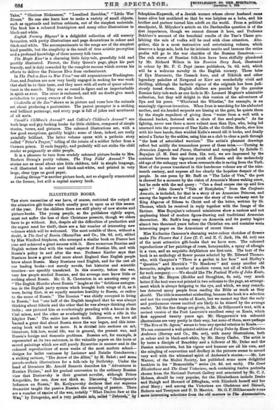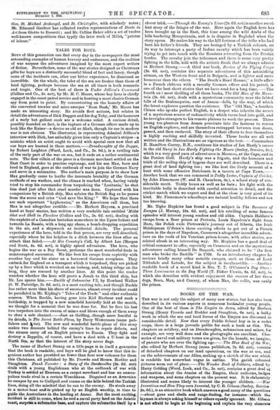ILLUSTRATED BOOKS.
THE stern necessities of war have, of course, restricted the output of the attractive gift-books which usually pour in upon us at this season of the year. For the children there are still plenty of new stories and picture-books. The young people, so the publishers rightly argue, must not suffer the loss of their Christmas presents, though we elders have to go without. But, despite all the difficulties of production and the urgent need for thrift, there are a fair number of interesting new volumes which will bo welcomed. The most notable of these, without a doubt, is The Soul of Russia (Macmillan and Co., 10s. 6d. not), edited by Miss Winifred Stephens, who arranged a similar book on Franco last year and achieved a great success with it. Here numerous Russian and English writers deal with the varied aspects of Russian life, and with Russia's policy in and after the war. Professor Kareev says that Ruesians know a great deal more about England than English people know about Russia. Many Russians road English, and for the rest all our leading books—not merely novels, but histories and scientific treatises—are speedily translated. In this country, before the war, very few people studied Russian, and the average man know little or nothing about Russia. Mr. G. K. Chesterton in an amusing essay on " The English Blunder about Russia " laughs at the " fictitious antagon- ism in the English party system which brought both wings of it, as it were, facing East, in an equally senseless hostility to Russia, or rather to the name of Russia." The Russian " was chiefly occupied in living in Russia," but "ono half of the English imagined that he was always thinking about Siberia and the other that ho was always thinking about India ; one pictured him as everlastingly parading with a knout in the Ural mines, and the other as everlastingly lurking with a rifle in the Khyber Pass." The satiro has much truth. However, we have all ]Darned a great deal about Russia since the war began, and this inter- esting book will teach us more. It is divided into sections on art, literature, folk-lore, social life, war in general, the present war, and Russia's foreign and domestic problems. Russian art, for example, is represented at its two o extremes, in the valuable papers on the icons or sacred paintings which are still purely Byzantine in manner and in the coloured reproductions of some works of the most modern school— designs for ballet costumes by Larionov and Natalie Goncharova ; a striking cartoon, "The Arrow of the Allies," by M. Bakst ; and some pseudo-archaic illustrations for a folk-tale by Stelletsky. Under the head of literature Mr. Arnold Bennett describes his " Adventures in Russian Fiction," and his gradual conversion to the ordinary Russian view that Dostoevsky is their greatest novelist, although Prince Kropotkin, for one, does not think so. Discussing " Shakespeare's Influence on Russia," Mr. Kotlyarevsky declares that our supreme dramatist taught the passive Russian the meaning of passion. There are a number of stpries of the war, notably " What Dmitro Saw at the War," by Potapenko, and a very pathetic tale, called "Deborah," by
Schepkina-Kupernik, of a Jewish woman whose clever husband came home alive but mutilated so that ho was helpless as a babe, and his brother and partner turned him adrift on the world. From a political standpoint, M. Milyukov's article on the Dardanelles question is of the first importance, though we cannot discuss it hero, and Professor Bekterev's account of the beneficial results of the Tsar's Ukaso pro- hibiting the sale of vodka will bo read with close attention. Alto. gether, this is a most instructive and entertaining volume, which deserves a large sale, both for its intrinsic merits and because the entire
profits will go to the war charities of the Russian Zemstvos. The rich stores of Russian folk-lore have been skilfully plundered by Mr. Richard Wilson in his Russian Story Book, illustrated in colour by Mr. P. C. Pape (same publishers, 7s. 6d. net), which will be a welco:no novelty in the English nursery. These tales of Ilya Murometz, the Cossack hero, and of Nikitich and other legendary paladins of Novgorod or Kiev are wonderfully vivid and thrilling, although the barbaric vigour of the originals has been judi- ciously toned down. English children are puzzled by the genuine Russian fairy-tale such as one finds in Mr. Leonard Magnus's admirable collection, but they will delight in this version of the adventures of Ilya and his peers. " Whirlwind the Whistler," for example, is an amazingly vigorous invention. When Ivan is searching for his abducted mother, and six-headed serpents are hissing at tho gate, ho quiets them by the simple expedient of giving theta "water from a well with a diamond bucket, fastened with a chain of fine seed-pearls." As for fighting, never was there a more valiant man than Ilya, who, being led unarmed into the presence of Tsar Kalin of the Golden Horde, slew him with his bare hands, then wielded KalM's sword till it broke, and finally seized a Tartar by the ankles, using him as a club to clear a path through " the host of astonished warriors." The artist's pleasant drawings reflect but mildly the tremendous power of these tales.—Turning to Armenian Legends and Poems, illustrated and compiled by Zabelle C. Boyajian (J. M. Dent and Sons, 21s. net), we are impressed by the contrast between the vigorous youth of Russia and the melancholy old age of the unhappy race whose remnants she is saving from the Turk. Most of the poems translated in this handsome volume are of the nine- teenth century, and express all too clearly the hopeless despair of the people. In one poem by Mr. Raffi on " The Lake of Van," the poet is cheered for a moment by the vision of Armenia's Muses waking anew, but he ends with the sad query : " Can a dead corpse rise up and live again ? " John Gower's " Tale of Rosiphelee," from the Confessio Amantis, is included, for that is a story of an Armenian Princess, and among the legends we find of course the story of the embassy sent by King Abgarus of Edessa to Christ and of the letter, written by St. Thomas, which he received in reply together with the Image of the Saviour. Miss Boyajian's coloured miniatures show a curious and not unpleasing blend of modern figure-drawing and traditional Armenian decoration. Mr. Raffi's long essay on Armenia and its poetry begins almost two thousand years before the Christian era and contains some interesting pages on the Armenians of recent times.
Miss Katharine Cameron's charming water-colour sketches of flowers make The Flowers that I Lore (T. C. and E. C. Jack, 10s. 6d. net) one of the most attractive gift-books that we have seen. The coloured reproductions of her paintings of roses, honeysuckle, a spray of allongia in a vase, and an exquisite de!phinium are first-rate. The text of the book is an anthology of flower poems selected by Mr. Edward Thomas, who, with Campion's " There is a garden in her face " and Shelley's " Question" and Herrick's " To Meadows " and many another old favourite, mingles a number of modern verses, not all of which are fit for such company. Wo should like The Poetical Works of John Keats, edited by Mr. Binyon (Hodder and Stoughton, 6s. net), very much better if the text were not printed in two columns to the page, an arrange- ment which is always fatiguing to the eye, and which, wo may remark, has deterred many people from reading the Bible as much as they should. The title is somewhat misleading, because the book is a selection and not the complete works of Keats, but we cannot say that the early and posthumous verses omitted are likely to bo missed by the average reader. All the fine things are given, in Mr. do Selincourt's text, with a revised version of the Poet Laureate's excellent essay on Keats, which first appeared twenty years ago. Mr. Shepperson's ten coloured illustrations are very pretty in their way, but none of them, save perhaps " The Eve of St. Agnes," seems to bear any special relation to Keats.— We can commend a well-printed edition of Fairy Tales by Hans Christian Andersen (Harrap and Co., 20s. net), with many illustrations, both in colour and in black-and-white, by Mr. Harry Clarke. The artist is by turns a disciple of Beardsley and a follower of Mr. Dulac and the Persian miniaturists, but his vigour and humour aro all his own, and the mingling of convention and drollery in the pictures seems to accord very well with the whimsical spirit of Andersen's stories.--Mr. Lee Warner, of the Medici Society, has published some more delightful booklets in his " Memorabilia " series (18. 6d. net each). The Great Elizabethans and The Great Victorians, each containing twelve portraits chosen from the National Portrait Gallery and annotated by Mr. C. J. Holmes, should be very popular, for the Elizabethans include Drake and Ralegh and Howard of Effingham, with Elizabeth herself and her rival Mary ; and among the Victorians are Gladstone and Disraeli, Roberts and Tennyson and F. D. Maurice. Mr. G. F. Hillhas made same more interesting selections from the old masters in The Annunciation,
lion, St. Michael Archangel, and St. Christopher, with scholarly notes ; Mr. Edmund Gardner has collected twelve representations of Dante in Art from Giotto to Rossetti ; and Mr. Collins Baker edits a sot of twelve well-known compositions that typify the later work of Millet, "painter of labour."













































 Previous page
Previous page